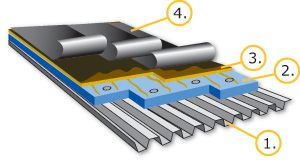Value through innovation polyglass is a leading manufacturer of modified bitumen roofing and waterproofing membranes and roof coatings for low and steep slope applications.
Modified membrane roof system.
Metal edge systems whether your roof specification calls for a traditional built up system a modified bitumen membrane system or a hybrid built up and modified bitumen system firestone is a partner you can count on to meet your asphalt roofing system requirements.
With a choice of cold or hot application and a range of performance levels all of which provide exceptional waterproofing protection for your building tremco roofing s powerply line of modified bitumen mb roofing solutions combine the advantages of advanced adhesives and membranes with the time tested reliable installation techniques of conventional built up roofing to provide a fully integrated long lasting roofing system.
Membrane roofs are most commonly used in commercial application though they are becoming increasingly common in residential application.
Membrane roofs are most commonly made from synthetic rubber thermoplastic pvc or similar material or modified bitumen.
App is a smooth surfaced membrane that is torched to an acceptable substrate and then coated to protect it from the uv.
Developed in europe in the mid 1960s modified bitumen roofing has been used in canada and the united states since about 1975.
Polyglass utilizes the most technologically advanced manufacturing processes in the industry with six state of the art manufacturing facilities five in the united states and one in italy which services all of europe.
Learn about modified bitumen app roofing systems.
Modified bitumen roofing systems there are two types of modified bitumen membranes app and sbs.
Get to know more about one of the most popular commercial roofing systems.
App membrane is applied using an open flame touch while sbs is hot mopped or adhered using a cold processive adhesive.
Membrane roofing is a type of roofing system for buildings and tanks.
It was developed as a means to improve roofing membranes when product quality was affected by the use of a lower quality crude oil by product.
It is used to create a watertight roof covering to protect the interior of a building.




























